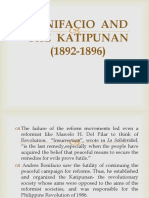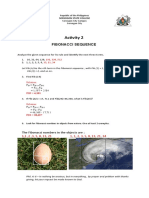0 ratings0% found this document useful (0 votes)
59 viewsTaxation During The Commonwealth Period
Taxation During The Commonwealth Period
Uploaded by
Mikylla Barcellano PunayThe document discusses taxation in the Philippines during the Commonwealth period from 1935 to 1946. It outlines changes made to the taxation system during this time including increases in income tax rates and the introduction of a national internal revenue code. The analysis section notes that the tax system placed most of the burden on the lower class while benefiting the upper class and politicians.
Copyright:
© All Rights Reserved
Available Formats
Download as PDF, TXT or read online from Scribd
Taxation During The Commonwealth Period
Taxation During The Commonwealth Period
Uploaded by
Mikylla Barcellano Punay0 ratings0% found this document useful (0 votes)
59 views8 pagesThe document discusses taxation in the Philippines during the Commonwealth period from 1935 to 1946. It outlines changes made to the taxation system during this time including increases in income tax rates and the introduction of a national internal revenue code. The analysis section notes that the tax system placed most of the burden on the lower class while benefiting the upper class and politicians.
Original Description:
Reading in Philippines History
Original Title
Taxation-During-the-Commonwealth-Period
Copyright
© © All Rights Reserved
Available Formats
PDF, TXT or read online from Scribd
Share this document
Did you find this document useful?
Is this content inappropriate?
The document discusses taxation in the Philippines during the Commonwealth period from 1935 to 1946. It outlines changes made to the taxation system during this time including increases in income tax rates and the introduction of a national internal revenue code. The analysis section notes that the tax system placed most of the burden on the lower class while benefiting the upper class and politicians.
Copyright:
© All Rights Reserved
Available Formats
Download as PDF, TXT or read online from Scribd
Download as pdf or txt
0 ratings0% found this document useful (0 votes)
59 views8 pagesTaxation During The Commonwealth Period
Taxation During The Commonwealth Period
Uploaded by
Mikylla Barcellano PunayThe document discusses taxation in the Philippines during the Commonwealth period from 1935 to 1946. It outlines changes made to the taxation system during this time including increases in income tax rates and the introduction of a national internal revenue code. The analysis section notes that the tax system placed most of the burden on the lower class while benefiting the upper class and politicians.
Copyright:
© All Rights Reserved
Available Formats
Download as PDF, TXT or read online from Scribd
Download as pdf or txt
You are on page 1of 8
CHAPTER IV: Social, Political, Economic, and Cultural
Issues in the Philippines
Taxation During the
Commonwealth Period
I. Introduction
• Taxation is the process by which the sovereign,
through its law making body, races revenues use to
defray expenses of government.
• The Commonwealth of the Philippines refers to a
period in Philippine history from 1935 to 1946.
During this time, the Philippines was a self-governing
territory under the sovereignty of the United States.
II. Changes in Taxation System
1936: Income tax rates increased, surtax added for
high earners.
1937: Cedula tax abolished (progressive move),
residence tax imposed on all citizens 18+
(regressive move).
II. Changes in Taxation System
• 1939: The Commonwealth government drafted
National Internal Revenue Code
1. Normal tax of 3 percent and the surtax on income
was replaced by a single tax at a progressive rate.
2. Personal exemptions were introduced.
3. Corporation income tax was slightly increased by
introducing taxes on inherited estates or gifts
donated in the name of dead persons.
II. Changes in Taxation System
4. The cumulative sales tax was replaced by a single
turnover tax of 10% on luxuries.
5. Taxes on liquors, cigarettes, forestry products,
and mining were increased.
6. Dividends were made taxable.
III. Analysis of the New System
The lower class bore most of the burden, while the
u p p e r cl a s s, e l i t e, a n d p o l i t i c i a n s b e n e f i t e d .
A gr i c u l t u re wa s favo re d w i t h l o w t a xe s, w h i ch
discouraged industrial investment. Taxation didn't help
diversify the economy or guide development.
IV. Taxation During World War II
The Japanese kept their existing system and
exempted their own supplies. Foreign trade decreased,
a n d m a i n t a x s o u rc e s s h i f t e d t o a mu s e m e n t s,
manufactures, etc. It was challenging to collect
taxes during the war. They used National Sweepstakes
and government bonds to raise more funds, and
military notes were issued to cover war costs.
V. Conclusion
Despite attempts at reform, tax system remained
unfair and ineffective in promoting economic
development.
You might also like
- Taxation During The Commonwealth PeriodDocument23 pagesTaxation During The Commonwealth PeriodcarolreynnNo ratings yet
- Taxation in PhilippineDocument11 pagesTaxation in PhilippineStephanie ManalastasNo ratings yet
- RPH-FINALS - Andes, Juvic A. - BSA1G2Document14 pagesRPH-FINALS - Andes, Juvic A. - BSA1G2Juvic AndesNo ratings yet
- Controversies in Philippine HistoryDocument4 pagesControversies in Philippine HistoryRondina, Elvie Rose P.100% (1)
- Reading The Proclamation of Philippine IndependenceDocument11 pagesReading The Proclamation of Philippine IndependenceCyreal James CamerosNo ratings yet
- Module I-Assignment 03 - Taking A Closer Look at Historical Sources - Primary Secondary and Tertiary (Individual Work)Document15 pagesModule I-Assignment 03 - Taking A Closer Look at Historical Sources - Primary Secondary and Tertiary (Individual Work)johannaNo ratings yet
- Evolution of The Philippine ConstitutionDocument7 pagesEvolution of The Philippine ConstitutionRocel DomingoNo ratings yet
- Evolution of Philippine TaxationDocument25 pagesEvolution of Philippine TaxationMary Grace AntiponaNo ratings yet
- Evolution of Taxation in The PhilippinesDocument16 pagesEvolution of Taxation in The Philippineshadji montanoNo ratings yet
- Lakas Sambayanan Video GuideDocument7 pagesLakas Sambayanan Video GuideBill LauloNo ratings yet
- Taxation of The PhilippinesDocument35 pagesTaxation of The PhilippinesFhatima Ashra Latip WajaNo ratings yet
- Module 2 RPHDocument21 pagesModule 2 RPHKristine KimNo ratings yet
- Analysis of The "Proclamation of The Philippine Independence"Document9 pagesAnalysis of The "Proclamation of The Philippine Independence"Dearly MayNo ratings yet
- Juliet SlidesCarnivalDocument36 pagesJuliet SlidesCarnivalGjianne Caubang MalikNo ratings yet
- GROUP 4 Content Contextual Analysis Kartilya NG KatipunanDocument4 pagesGROUP 4 Content Contextual Analysis Kartilya NG KatipunanLJ GundayNo ratings yet
- Content and Contextual Analysis: Speech of Corazon AquinoDocument8 pagesContent and Contextual Analysis: Speech of Corazon AquinoShenn ShennNo ratings yet
- KKK and The Kartilya NG Katipunan - draB3PGkDocument11 pagesKKK and The Kartilya NG Katipunan - draB3PGkRoschelle MiguelNo ratings yet
- The Proclamation of The Philippine Independence (Ivyyy)Document10 pagesThe Proclamation of The Philippine Independence (Ivyyy)Katherine Usquisa TorrenaNo ratings yet
- First Voyage Around The WorldDocument5 pagesFirst Voyage Around The WorldAmer ArtesanoNo ratings yet
- Bonifacio and The KatipunanDocument9 pagesBonifacio and The KatipunanCandyjane ParoleNo ratings yet
- Bonifacio and Katipunan PDFDocument39 pagesBonifacio and Katipunan PDFAllyn Adams GravadorNo ratings yet
- Antonio Pigafetta. First Voyage Around The World, (Chronicle)Document11 pagesAntonio Pigafetta. First Voyage Around The World, (Chronicle)Mira Flor Marante AndersonNo ratings yet
- Republic of The Philippines Office of The President Commission On Higher EducationDocument22 pagesRepublic of The Philippines Office of The President Commission On Higher EducationJulius RimasNo ratings yet
- Midterms 2ND ActivityDocument2 pagesMidterms 2ND ActivityRusty PadillaNo ratings yet
- Indolence of The FilipinosDocument3 pagesIndolence of The Filipinoskurou hazamaNo ratings yet
- Philippine History Lesson 11Document36 pagesPhilippine History Lesson 11Sun Tea Seguin80% (5)
- Ge02 CHP 4 l1 Monastic Supremacy in The Philippines Merged CompressedDocument73 pagesGe02 CHP 4 l1 Monastic Supremacy in The Philippines Merged CompressedJacoba, Michaela JasmineNo ratings yet
- Leonard Wood As Governor General-A Calendar of Selected CorrespondenceDocument22 pagesLeonard Wood As Governor General-A Calendar of Selected CorrespondenceTaliNo ratings yet
- Alfred McCoy Political Caricatures of The American EraDocument33 pagesAlfred McCoy Political Caricatures of The American EraSerg's Bihag IVNo ratings yet
- (LESSON 2) - HIST1023 - Life and Works of RizalDocument22 pages(LESSON 2) - HIST1023 - Life and Works of RizalJazzle eirol tanNo ratings yet
- G4 - Agrarian ReformDocument9 pagesG4 - Agrarian ReformMarcNo ratings yet
- Group 2 Evolution of Philippine ConstitutionDocument23 pagesGroup 2 Evolution of Philippine ConstitutionZion WilliamsonNo ratings yet
- Batas Militar - Martial Law in The PhilippinesDocument3 pagesBatas Militar - Martial Law in The PhilippinesRinalyn AsuncionNo ratings yet
- Rizal's Retraction From A Master Mason's PerspectiveDocument9 pagesRizal's Retraction From A Master Mason's PerspectivePaul BilaoenNo ratings yet
- 1935 Commonwealth Constitution (Tydings Mcduffie)Document9 pages1935 Commonwealth Constitution (Tydings Mcduffie)Maria Janina ManiquizNo ratings yet
- DocxDocument8 pagesDocxag832bNo ratings yet
- Braga-Batistil - The Retraction of RizalDocument27 pagesBraga-Batistil - The Retraction of RizalEssielve BatistilNo ratings yet
- Reflection Paper PlasenciaDocument1 pageReflection Paper PlasenciaBrent Carlos NacpilNo ratings yet
- Corazon C. Aquino (1986-1992)Document8 pagesCorazon C. Aquino (1986-1992)Rowena LupacNo ratings yet
- Taxation in Spanish Philippines: Evolution of Philippine TaxationDocument16 pagesTaxation in Spanish Philippines: Evolution of Philippine TaxationC. I .ANo ratings yet
- Report in HistoryDocument37 pagesReport in HistoryDaphane Kate AureadaNo ratings yet
- Cultural Guide For International StudentsDocument3 pagesCultural Guide For International StudentsDIANE FAE FETALVERONo ratings yet
- Taxation During Commonwealth PeriodDocument18 pagesTaxation During Commonwealth PeriodLEIAN ROSE GAMBOA100% (2)
- The KatipunanDocument5 pagesThe KatipunanMabelle Esconde AcostaNo ratings yet
- Joven FibonacciDocument2 pagesJoven FibonacciZer John GamingNo ratings yet
- The Malolos ConstitutionDocument9 pagesThe Malolos ConstitutionErica BorbonNo ratings yet
- RPH Lesson 3 Tagalog CustomsDocument39 pagesRPH Lesson 3 Tagalog CustomsMark Zed Dela CruzNo ratings yet
- The 1897 Biak Na Bato ConstitutionDocument4 pagesThe 1897 Biak Na Bato ConstitutionFaith Ann CortezNo ratings yet
- American PeriodDocument8 pagesAmerican PeriodGeansylle BollenaNo ratings yet
- 1 Customs of The TagalogDocument3 pages1 Customs of The TagalogMille KaiaNo ratings yet
- Readings in Philippine History Evolution of Philippine TaxationDocument4 pagesReadings in Philippine History Evolution of Philippine TaxationAngel Joseph Tejada100% (1)
- 8 Carper-And-The-Future-Of-Agrarian-Reform-In-The-Philippines-Group-8Document5 pages8 Carper-And-The-Future-Of-Agrarian-Reform-In-The-Philippines-Group-8Random internet person100% (1)
- BSHM 1-4 - Group 5 - KartillaDocument25 pagesBSHM 1-4 - Group 5 - KartillaKatricia Elaine VillanuevaNo ratings yet
- GE-9-Power-Point-Presentation (GROUP 3)Document56 pagesGE-9-Power-Point-Presentation (GROUP 3)ANGELA MAY GAMUTANNo ratings yet
- Reading The Proclamation of Philippine Independence': Gec2 Reporters: Cluster E Instructor: Mr. Christian Louie PajaronDocument9 pagesReading The Proclamation of Philippine Independence': Gec2 Reporters: Cluster E Instructor: Mr. Christian Louie PajaronPaul Niño LagareNo ratings yet
- A Brief Summary of The First Voyage Around The World by MagellanDocument5 pagesA Brief Summary of The First Voyage Around The World by Magellanjonie claire pallayocNo ratings yet
- Site of The First Mass: Module 2/topic 1Document6 pagesSite of The First Mass: Module 2/topic 1A ASSD100% (1)
- The Two Faces of The 1872 Cavite MunityDocument9 pagesThe Two Faces of The 1872 Cavite Munityjefferson paculbaNo ratings yet
- Acta de La Proclamación de Independencia Del Pueblo FilipinoDocument31 pagesActa de La Proclamación de Independencia Del Pueblo Filipinocristinesilva0% (1)



























































